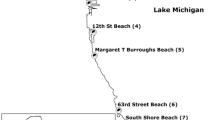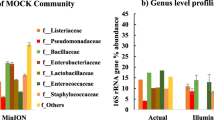Abstract
The US EPA is currently investigating the use of quantitative PCR (qPCR) analysis techniques to estimate densities of fecal indicator bacteria (FIB) in recreational waters. Present water quality guidelines, based on culturable FIB, prevent same day water quality determination, whereas results from qPCR-based approaches are available within several hours. Epidemiological studies at Publicly-Owned Treatment Works (POTW)-impacted freshwater beaches have also indicated correlations between qPCR determined Enterococcus densities and swimming-related illness rates. Similar qPCR assays are now available for several other accepted or emerging FIB groups. This study provides an initial assessment of qPCR estimated Enterococcus, Bacteroidales, E. coli and Clostridium spp. densities in marine water and sand samples collected over one summer from two POTW-impacted recreational beaches. Relative target sequence densities of these organisms in the samples did not correspond with their relative estimated cell densities. These observations were attributable to differences in target sequences recovered from the calibrator cells of the different types of organisms. Comparative cycle threshold (CT) qPCR analyses of whole cell calibrator samples provide a simple and standardizable approach for estimating both total cell and target sequence densities of different types of FIB in water. Cell density estimates obtained by this approach are subject to uncertainty due to potential variability in absolute numbers of target sequences in the target organisms under different physiological or environmental conditions, but still may allow for informative comparisons with the target sequence estimates.
Similar content being viewed by others
References
Anderson KL, Whitlock JE, Harwood VJ (2005) Persistence and differential survival of fecal indicator bacteria in subtropical waters and sediments. Appl Environ Microbiol 71(6):3041–3048
Applied Biosystems (1997) ABI Prism 7700 Sequence Detection System. User Bulletin #2. Applied Biosystems Corporation, Foster City, CA, USA
Bej AK, DiCesare JL, Haff L, Atlas RM (1991) Detection of Escherichia coli and Shigella spp. in water by using the polymerase chain reaction and gene probes for uid. Appl Environ Microbiol 57(4):1013–1017
Bernhard AE, Field KG (2000) A PCR assay to discriminate human and ruminant feces on the basis of host differences in bacteroides-prevotella gene encoding 16S rRNA. Appl Environ Microbiol 66(10):4571–4574
Bisson JW, Cabelli VJ (1979) Membrane filter enumeration method for Clostridium perfringens. Appl Environ Microbiol 37(1):55–66
Boehm AB (2007) Enterococci concentrations in diverse coastal environments exhibit extreme variability. Environ Sci Technol 41(24):8227–8232
Brinkman NE, Haugland RA, Wymer L, Byappanahalli M, Whitman RL, Vesper SJ (2003) Evaluation of a rapid, quantitative real-time PCR method for enumeration of pathogenic Candida cells in water. Appl Environ Microbiol 69(3):1775–1782
Cole JR, Chai B, Farris RJ, Wang Q, Kulam-Syed-Mohideen AS, McGarrell DM, Bandela AM, Cardenas E, Garrity GM, Tiedje JM (2007) The ribosomal database project (RDP-II): introducing myRDP space and quality controlled public data. Nucleic Acids Res 35:169–172
Desmarais TR, Solo-Gabriele HM, Palmer CJ (2002) Influence of soil on fecal indicator organisms in a tidally influenced subtropical environment. Appl Environ Microbiol 68(3):1165–1172
Dick LK, Field KG (2004) Rapid estimation of numbers of fecal Bacteroidetes by use of a quantitative PCR assay for 16S rRNA genes. Appl Environ Microbiol 70(9):5695–5697
Donovan E, Unice K, Roberts JD, Harris M, Finley B (2008) Risk of gastrointestinal disease associated with exposure to pathogens in the water of the Lower Passaic River. Appl Environ Microbiol 74(4):994–1003
Dufour AP (1984) Health effects criteria for fresh recreational waters. US Environmental Protection Agency, Washington, DC
Fiksdal L, Maki JS, LaCroix SJ, Staley JT (1985) Survival and detection of Bacteroides spp., prospective indicator bacteria. Appl Environ Microbiol 49(1):148–150
Fujioka RS, Shizumura LK (1985) Clostridium perfringens, a reliable indicator of stream water quality. J Water Pollut Control Fed 57(10):986–992
Guy RA, Payment P, Krull U, Horgen PA (2003) Real-time PCR for quantification of giardia and cryptosporidium in environmental water samples and sewage. Appl Environ Microbiol 69(9):5178–5185
Gyles C, Johnson R, Gao A, Ziebell K, Pierard D, Aleksic S, Boerlin P (1998) Association of enterohemorrhagic Escherichia coli hemolysin with serotypes of shiga-like-toxin-producing Escherichia coli of human and bovine origins. Appl Environ Microbiol 64(11):4134–4141
Haugland R, Siefring S, Varma M, Atikovic E, Brenner K, Dufour A (2006) Evaluation of matrix effects from nationwide inland surface waters on quantitation polymerase chain reaction analysis for fecal indicator bacteria. National Beaches Conference, Niagara Falls, NY, 11–13 October
Haugland RA, Siefring S, Wymer L, Brenner K, Dufour A (2005) Comparison of Enterococcus measurements in freshwater at two recreational beaches by quantitative polymerase chain reaction and membrane filter culture analysis. Water Res 39:559–568
Heid C, Stevens J, Livak KJ, Williams PM (1996) Real time quantitative PCR. Genome Res 6:986–994
Jackson JH, Schmidt TM, Herring PA (2008) A systems approach to model natural variation in reactive properties of bacterial ribosomes. BMC Syst Biol 2:62
Khan IU, Gannon V, Kent R, Koning W, Lapen DR, Miller J, Neumann N, Phillips R, Robertson W, Topp E, van Bochove E, Edge TA (2007) Development of a rapid quantitative PCR assay for direct detection and quantification of culturable and non-culturable Escherichia coli from agriculture watersheds. J Microbiol Methods 69(3):480–488
Kildare BJ, Leutenegger CM, McSwain BS, Bambic DG, Rajal VB, Wuertz S (2007) 16S rRNA-based assays for quantitative detection of universal, human-, cow-, and dog-specific fecal Bacteroidales: a Bayesian approach. Water Res 41(16):3701–3715
Kim JH, Grant SB (2004) Public mis-notification of coastal water quality: a probabilistic evaluation of posting errors at Huntington Beach, California. Environ Sci Technol 38(9):2497–2504
Klappenbach JA, Saxman PR, Cole JR, Schmidt TM (2001) rrndb: the ribosomal RNA operon copy number database. Nucleic Acids Res 29(1):181–184
Kreader CA (1995) Design and evaluation of Bacteroides DNA probes for the specific detection of human fecal pollution. Appl Environ Microbiol 61:1171–1179
Kurmayer R, Kutzenberger T (2003) Application of real-time PCR for quantification of microcystin genotypes in a population of the toxic cyanobacterium microcystis sp. Appl Environ Microbiol 69(11):6723–6730
Layton A, McKay L, Williams D, Garrett V, Gentry R, Sayler G (2006) Development of Bacteroides 16S rRNA gene taqman-based real-time PCR assays for estimation of total, human, and bovine fecal pollution in water. Appl Environ Microbiol 72(6):4214–4224
Ludwig W, Schleifer KH (2000) How quantitative is quantitative PCR with respect to cell counts? Syst Appl Microbiol 23(4):556–562
Matsuki T, Watanabe K, Fujimoto J, Takada T, Tanaka R (2004) Use of 16S rRNA gene-targeted group-specific primers for real-time PCR analysis of predominant bacteria in human feces. Appl Environ Microbiol 70(12):7220–7228
Mazel D, Houmard J, Castets AM, Tandeau de Marsac, N. (1990) Highly repetitive DNA sequences in cyanobacterial genomes. J Bacteriol 172(5):2755–2761
Medema GJ, Bahar M, Schets FM (1997) Survival of Cryptosporidium parvum, Escherichia coli, Faecal enterococci and Clostridium perfringens in river water: influence of temperature and autochthonous microorganisms. Water Sci Tech 35(11–12):249–252
Noble RT, Griffith J, Blackwood D, Fuhrman J, Gregory J, Hernandez X, Liang X, Bera A, Schiff K (2006) Multitiered approach using quantitative PCR to track sources of fecal pollution affecting Santa Monica Bay, California. Appl Environ Microbiol 72(2):1604–1612
Noble RT, Moore DF, Leecaster MK, McGee CD, Weisberg SB (2003) Comparison of total coliform, fecal coliform and Enterococcus bacterial indicator response for ocean recreational water quality testing. Water Res 37:1637–1643
Okabe S, Okayama N, Savichtcheva O, Ito T (2007) Quantification of host-specific Bacteroides-Prevotella 16S rRNA genetic markers for assessment of fecal pollution in freshwater. Appl Microbiol Biotechnol 74(4):890–901
Read SC, Clarke RC, Martin A, De Grandis SA, Hii J, McEwen S, Gyles CL (1992) Polymerase chain reaction for detection of verocytotoxigenis Escherichia coli isolated from animal and food sources. Mol Cell Probes 6(2):153–161
Rinttilä T, Kassinen A, Malinen E, Krogius L, Plava A (2004) Development of an extensive set of 16S rDNA-targeted primers for quantification of pathogenic and indigenous bacteria in faecal samples by real-time PCR. J Appl Microbiol 97:1166–1177
Savichtcheva O, Okabe S (2006) Alternative indicators of fecal pollution: relations with pathogens and conventional indicators, current methodologies for direct pathogen monitoring and future application perspectives. Water Res 40(13):2463–2476
Shanks OC, Atikovic E, Blackwood AD, Lu J, Noble RT, Domingo JS, Siefring S, Sivaganesan M, Haugland RA (2008) Quantitative PCR for detection and enumeration of genetic markers of bovine fecal pollution. Appl Environ Microbiol 74(3):745–752
Shannon KE, Lee DY, Trevors JT, Beaudette LA (2007) Application of real-time quantitative PCR for the detection of selected bacterial pathogens during municipal wastewater treatment. Sci Total Environ 382(1):121–129
Shibata T, Solo-Gabriele HM, Fleming LE, Elmir S (2004) Monitoring marine recreational water quality using multiple microbial indicators in an urban tropical environment. Water Res 38(13):3119–3131
Siefring S, Varma M, Atikovic E, Wymer L, Haugland R (2007) Improved real-time PCR assays for the detection of fecal indicator bacteria in surface waters with different instrument and reagent systems. J Water Health 6(2):225–237
Smith C, Hill V (2009) Dead-end hollow-fiber ultrafiltration for recovery of diverse microbes from water. Appl Environ Microbiol 75(16):5284–5289
Sivaganesan M, Haugland R, Chern E, Shanks O (2009) Alternative Bayesian real-time PCR strategies for generation of calibration equations for absolute quantification of nucleic acids. BMC Bioinformatics. Submitted for publication
US Environmental Protection Agency (1986) Ambient water quality criteria for bacteria—1986. EPA 440/5-84/002. Criteria and Standards Division, US Environmental Protection Agency, Washington, DC
Wade TJ, Calderon RL, Brenner KP, Sams E, Beach M, Haugland R, Wymer L, Dufour A (2008) High sensitivity of children to swimming-associated gastrointestinal illness. Epidemiology 19(3):375–383
Wade TJ, Calderon RL, Sams E, Beach M, Brenner KP, Williams AH, Dufour AP (2006) Rapidly measured indicators of recreational water quality are predictive of swimming-associated gastrointestinal illness. Environ Health Perspect 114(1):24–8
Wade TJ, Pai N, Eisenberg JN, Colford JM Jr (2003) Do US Environmental Protection Agency water quality guidelines for recreational waters prevent gastrointestinal illness? A systematic review and meta-analysis. Environ Health Perspect 111(8):1102–1109
Walters S, Field K (2009) Survival and persistence of human and ruminant-specific faecal Bacteroidales in freshwater microcosms. Environ Microbiol 11(6):1410–1421
Wang RF, Cao WW, Cerniglia CE (1996) PCR detection and quantitation of predominant anaerobic bacteria in human and animal fecal samples. Appl Environ Microbiol 62(4):1242–1247
Wymer LJ, Dufour AP, Brenner KP, Martinson JW, Stutts WR, Schaub SA (2004) The EMPACT beaches project. Results and recommendations from a study on the microbiological monitoring of recreational waters. EPA 600/R-04/023, 2004. US Environmental Protection Agency, Office of Research and Development, Washington, DC
Yamahara KM, Layton BA, Santoro AE, Boehm AB (2007) Beach sands along the California coast are diffuse sources of fecal bacteria to coastal waters. Environ Sci Technol 41(13):4515–4521
Author information
Authors and Affiliations
Corresponding author
Rights and permissions
About this article
Cite this article
Chern, E.C., Brenner, K.P., Wymer, L. et al. Comparison of Fecal Indicator Bacteria Densities in Marine Recreational Waters by QPCR. Water Expo. Health 1, 203–214 (2009). https://doi.org/10.1007/s12403-009-0019-2
Received:
Accepted:
Published:
Issue Date:
DOI: https://doi.org/10.1007/s12403-009-0019-2




